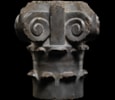Umayyad Capital
Umayyad Capital
Iberian, Umayyad
10th - 11th Century B.C.
Limestone
H: 29 x W: 16 cm
Sold
Exquisitely carved and finely polished in green limestone. In the form of a cylindrical shaft surmounted by a protruding rectangular section, creating a T-shaped profile. The lower body is decorated with two tiers of carved foliage, representing acanthus leaves, and the upper body’s four corners are designed as protruding, curling articulated scrolls, volutes, with a vertical rectangular panel between.
The surface of the limestone has been polished smooth. Its style is based on classic Corinthian capitals, but simplified, without their characteristic complex openwork. This type of reduced classical style is present in Visigothic Spanish architecture, as well as in Umayyad and Mozarabic architecture and later Almohad styles. Roman columns and capitals were incorporated into Spanish architectural planning after the Muslim conquest, and column capitals made in Spain soon after were originally similar in form and decoration. This incorporation of Roman spolia and style could be seen as an attempt at establishing Caliphal legitimacy through a continuation of architectural forms, and was part of the revival and promotion of classical antiquity practised by the Umayyad caliphate and their early successors in al-Andalus.
Ornate capitals such as this would have decorated a grand mosque or wealthy private residence, and very similar ones are still extant in several parts of the Great Mosque of Córdoba, flanking the mosaic mihrab and nearby, dating to the 10th century, where Roman columns and capitals are also present. Other, slightly later, similar examples are found in the Alhambra Museum, belonging to the Almohad dynasty, a Berber dynasty who took power after the Almoravids in the 12th century and were very indebted both to Almoravid but particularly to Umayyad artistic traditions.
The dating of the current capital to 10th-11th century places the capital as belonging to the Caliphate of Córdoba, a period of great Umayyad prosperity and cultural expansion in Iberia after the dynasty had been ousted from Damascus by the Abbasids. The age is characterised by complex and ornate building projects which include the Great Mosque of Córdoba and the palace-city complex of Madinat al-Zahra, outside Córdoba. This power and influence in echoed here, in the confident lines of the volutes.
Previously in the Private Collection of Mariano Contreras Granja (23rd July 1853 – 28th December 1912), architect and director of conservation at the Alhambra.
Thence by descent to his daughter Elena Granja.
Thence by descent to her daughter Christina Gómez Contreras.
Thence by descent (accompanied by Spanish export license)
ALR: S00213851
Mariano Contreras Granja (1853 – 1912), third in a family of important restorers of the Alhambra Palace, was a man entirely immersed in the history and understanding of the architectural traditions of Muslim Spain. In 1821 an earthquake damaged the Alhambra and an extensive repair programme was planned in 1828 by the architect José Contreras and endowed by Ferdinand VII in 1830. After the death of Contreras in 1847 his son Rafael Contreras Muñoz took over his work, continuing it for almost four decades, until he passed the work to his son, Mariano Contreras Granja.
Mariano thus comes from a dynasty intimately linked with the finest Umayyad architecture in the world, having been brought up surrounded by it. He trained first in an arabesque casting workshop, where some of his work was included in the 1878 Paris Exposition Universelle (World Fair), where he obtained a Gold Medal. He then trained as an architect in Madrid and was appointed assistant architect in the conservation works at the Alhambra shortly after graduating, being made director of conservation at the Alhambra on April 18, 1890, on his father’s death, at the proposal of the Monuments Commission, who took into account his “profound knowledge in Arab art.” That this capital comes from his private collection is testament to its quality and historical interest.










 Enquire
Enquire




